GIGABYTE GB-BXi7H-5500 Broadwell BRIX Review
by Ganesh T S on January 29, 2015 7:00 AM ESTGaming Benchmarks
Intel's integrated GPUs don't have a big name in the gaming community. Once in a while, Intel throws in a surprise. In the Haswell family, CPUs with Iris Pro graphics gave a pleasant surprise to casual gamers. In this section, we will identify whether the Intel HD Graphics 5500 in the Core i7-5500U can provide an acceptable gaming experience.
For the purpose of benchmarking, we chose four different games (Sleeping Dogs, Tomb Raider, Bioshock Infinite and DiRT Showdown) at three different quality levels. As someone focusing on HTPCs and multimedia aspects, I rarely get to process gaming benchmarks, even while evaluating GPUs. One of the aspects that I feared was spending lot of time in installing the same games again and again on different PCs under the review scanner. The solution was to go the Steam route. Unfortunately, Steam also likes to keep the game files updated. A quick online search revealed that Steam could make use of an external drive for storing the game executables and downloadable content. With the Steam drive on-the-go use-case being read-heavy, the Corsair Flash Voyager GS USB 3.0 128GB Flash Drive (with read speeds of up to 275 MBps) was ideal for use as a portable Steam drive.
Sleeping Dogs
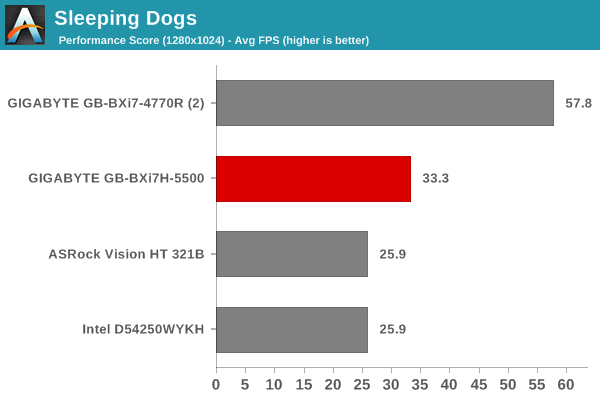


Tomb Raider
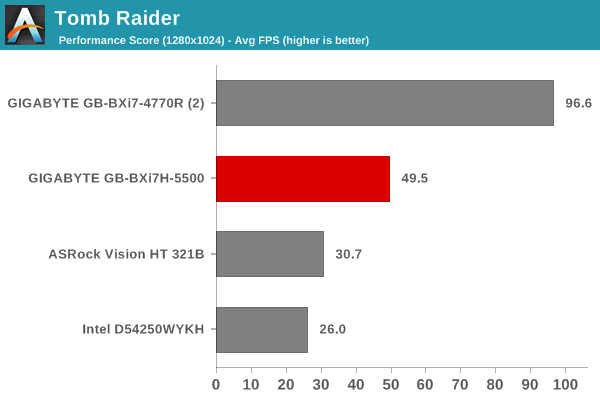
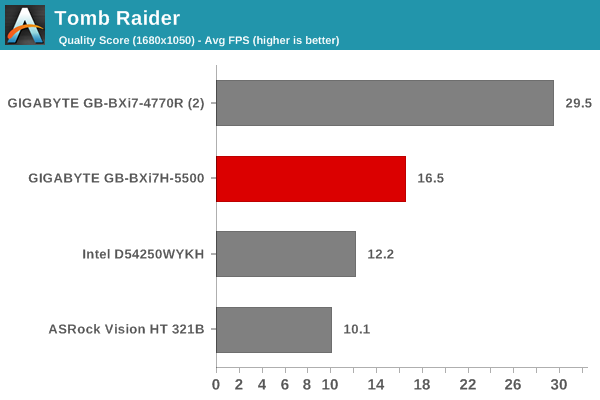
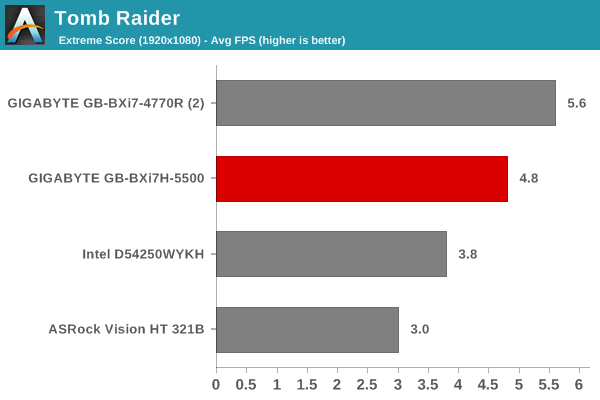
Bioshock Infinite
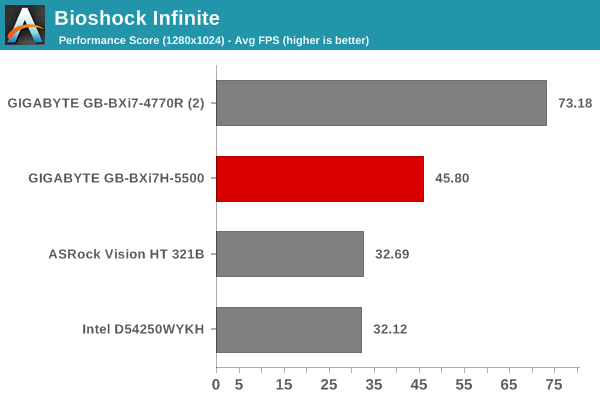
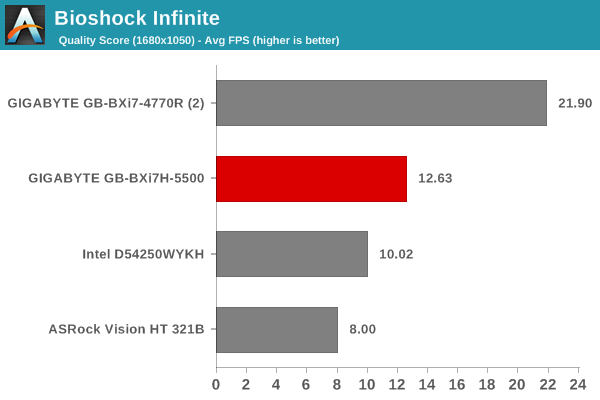
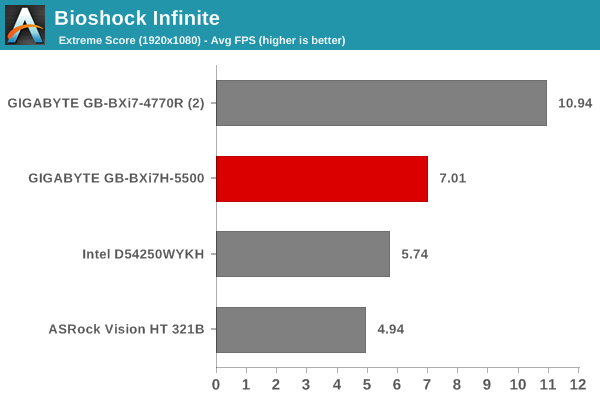
Tomb Raider
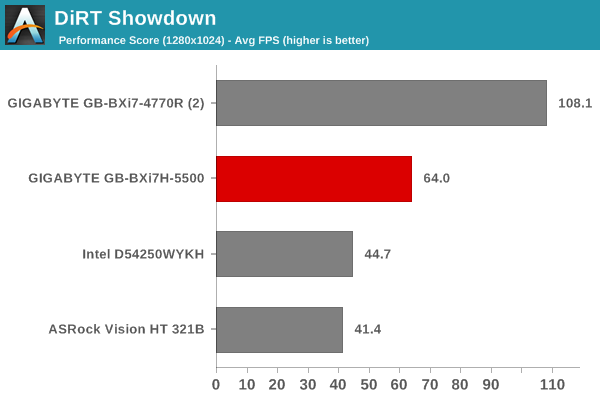
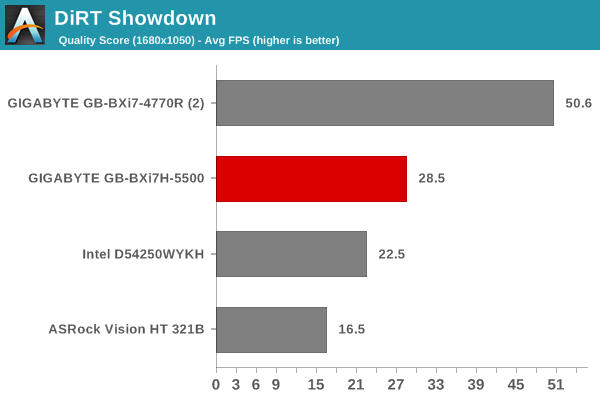
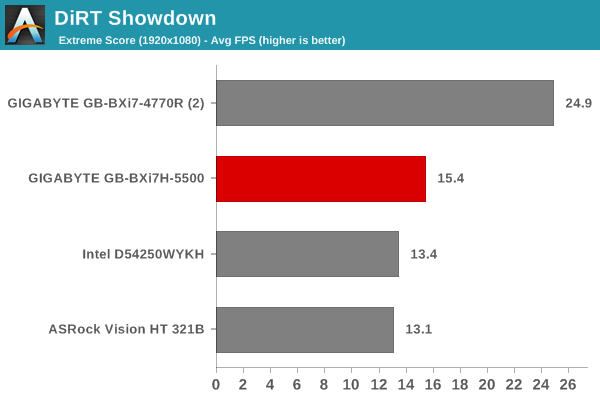
All the gaming benchmarks show a clear trend - users are getting better and better gaming performance with each successive generation of Intel GPUs. The Iris Pro-equipped systems still lead the pack by quite a distance, but, the power consumption profile is quite different. For the considered games, the GB-BXi7H-5500 can provde 30+ fps only in the lowest quality settings. These results are not entirely unexpected for Broadwell GT2. Systems based on Broadwell GT3e graphics (Iris Pro) are going to be the ones targeting the gaming community.










53 Comments
View All Comments
jaydee - Thursday, January 29, 2015 - link
I was hoping for a bit more here from Intel. Looking at the encoding, compressing, encrypting benchmarks, almost nothing was gained performance-wise, or in terms of power consumption.Flunk - Thursday, January 29, 2015 - link
Broadwell is an incremental update so it's not a big surprise.gonchuki - Thursday, January 29, 2015 - link
Doesn't even look incremental, more like a step revision of Haswell (just a node shrink and nothing else). It's the same processor Intel launched in 2013, but on a 14nm node.Refuge - Thursday, January 29, 2015 - link
Tick Tock Tick Tock.Although I've noticed their "Tick Tock" Has been slightly off cadence since their "Mobile First" strategy.
quophog - Friday, January 30, 2015 - link
No surprise really. No competition at all at the performance end. All their effort is going in to the ultra low power & cost end where ARM based architectures currently dominate. Very sad for everyone (except intel share holders) that AMD couldn't keep up with Intel R&D and fab spending.It's a long way off anyway, but I really hope Intel fab advantage doesn't let them eventually monopolise mobile procs too..
Haravikk - Friday, January 30, 2015 - link
Is that really such a bad thing? Making a smaller, much more power efficient processor without sacrificing any performance is still a pretty big accomplishment. While it might not make existing machines much more exiting, the really interesting part is what new things it makes possible.It's for this reason I hate this new Brix machine; it's the same horrific chassis as before, the with the same anaemic cooling. It should be possible for this to be entirely passively cooled, particularly if they want for a smaller, flatter, aluminium design.
eanazag - Friday, January 30, 2015 - link
Intel has done well, but with a competitive AMD we get better prices and more features. ARM has kept Intel moving, but look at the server market. Prices run from $200+ - north of $2000 for 2P systems. And Intel has the middle filled out too. Intel is charging whatever the hell they want there.eanazag - Friday, January 30, 2015 - link
It does look incremental in some benches. In others it is on par. For this type of system I would be leaning towards the 4770R. I don't care for the gaming performance on the 5500U. It is fine at 1280x1024/1366x768. I'd rather have the option to take a step up. The 4770R can do decent in 1600x900/1600x1000. For $750+ I'd like to be doing better. Broadwell Iris Pro may be what I'm hoping for.Otherwise, I'm a 5500U with a mobile GPU built-in - pricing and features may see which way I lean. I'm not a HTPC user.
nathanddrews - Thursday, January 29, 2015 - link
I don't think we should jump to judgment based upon multiple platforms with vastly different components. The closest competitor in this review is the 4500U, which the 5500U decimates in half the benchmarks, while leading it by at least a small margin in the rest. I'm looking forward to a more controlled, thorough review of Broadwell.I know that the gaming tests are set in stone and you try not to change them, but can we please drop the 1280x1024 test and replace it with 1280x720? It's 30% less taxing for these weak GPUs and is much more likely to be used by gamers - either on HDTVs, notebook displays (768p), and widescreen monitors. Nearly all 360/PS3 games are 720p, so many people are comfortable with that resolution and it scales to 1080p, 1440p, and 4K. It's just more realistic. No one games at 1280x1024 anymore unless they like pillarboxing and letterboxing at the same time. 720p and 1080p are really the only meaningful resolutions for these GPUs. You can save yourself some time, too...
ATC9001 - Thursday, January 29, 2015 - link
+1 for 720p resolution. If possible atleast add this to existing HTPC benchmarking, and of course when the benchmark is revamped for it's next iteraion, drop 1280x1024 completely!